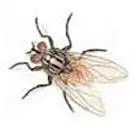House Flies: A Deep Dive into Their Nasty Side
The house fly, scientifically known as Musca domestica, is a common pest found worldwide. While they may seem like mere annoyances buzzing around our homes, these insects carry a much darker side. Here’s a detailed look at house flies and… Read More »House Flies: A Deep Dive into Their Nasty Side


